Smartphones & Tablets | April 18, 2024
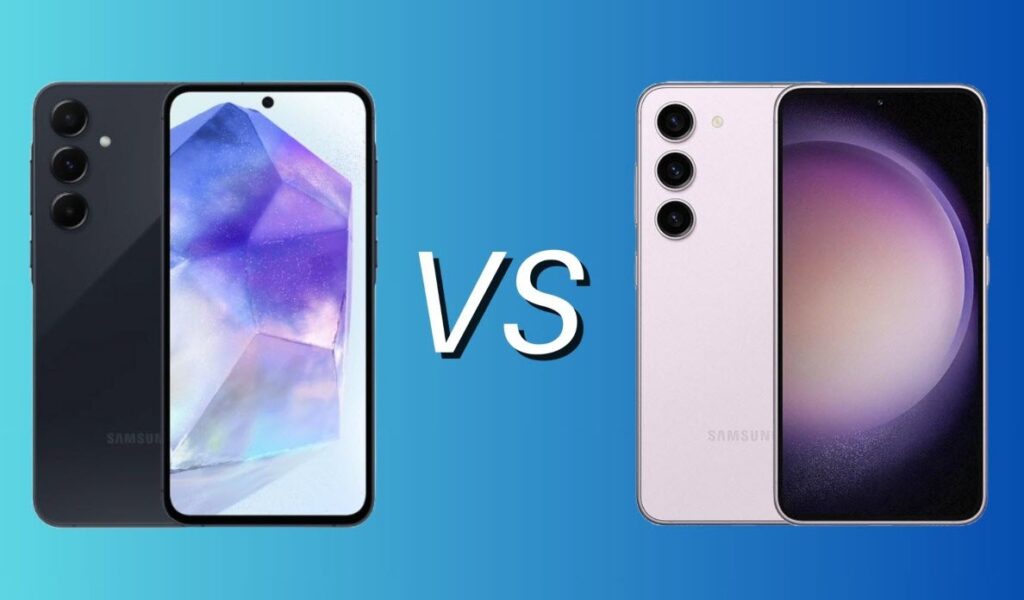
| Samsung Galaxy A55 | Samsung Galaxy S23 | |
| Screen | 6.6 inches of Super AMOLED technology, 19.5:9 format, FullHD+ resolution of 2,340 x 1,080 pixels, 120 Hz refresh rate, 240 Hz touch sampling rate, 1,000 nits maximum brightness and Corning Gorilla Glass Victus+ protection | 6.1 inches of 2X LTPO Dynamic AMOLED technology, 19.5:9 format, FullHD+ resolution of 2,340 x 1,080 pixels, 120 Hz adaptive refresh rate (48-120 Hz), 240 Hz touch sampling rate, maximum brightness 1,750 nits, HDR10+ and Corning Gorilla Glass Victus 2 protection |
| Main Camera | – 50 megapixel main sensor with f/1.8 focal aperture with video recording capacity in 4K resolution at 30 frames per second – Secondary sensor with 12 megapixel wide-angle lens with f/2.2 aperture – Tertiary macro sensor 5 megapixels with f/2.4 aperture | – 50 megapixel main sensor with f/1.8 focal aperture with video recording capacity in 8K resolution at 30 frames per second – Secondary sensor with 10 megapixel telephoto lens with f/2.4 focal aperture and 3X optical zoom – Tertiary sensor with 12 megapixel wide-angle lens with f/2.2 focal aperture |
| Selfie Camera | 32 megapixel main sensor with f/2.2 focal aperture with video recording capacity in 4K resolution at 30 frames per second | 12 megapixel main sensor with f/2.2 focal aperture with video recording capacity in 4K resolution at 60 frames per second |
| Internal Memory | 128 or 256 GB of UFS 2.2 type | – 128 GB UFS 3.1 – 256 GB UFS 4.0 |
| Extension | Expandable via microSD card up to 1 TB | Not expandable |
| Processor and RAM memory | – 4-nanometer, eight-core Exynos 1480 at 2.75 GHz max. – 8 GB of LPDDR4 type RAM | – Qualcomm Snapdragon 8 Gen 2 4-nanometer eight-core 3.36 GHz max. – 8 GB of LPDDR5 type RAM |
| Battery | 5,000 mAh with support for 25W fast wired charging (charger not included in the box) | 3,900 mAh with 25W fast wired charging (charger not included in the box), 10W wireless charging and 4.5W reverse wireless charging |
| OS | Android 14 under One UI 6.1 (upgradable up to Android 18) | Android 14 under One UI 6 (upgradable up to Android 17) |
| Connections | 5G, 4G LTE, dual-band Wi-Fi 802.11 a/b/g/n/ac/6, Bluetooth 5.3, GPS with A-GPS and GLONASS, NFC for contactless mobile payments and USB type C | 5G, 4G LTE, dual-band WiFi 802.11 a/b/g/n/ac/6e, Bluetooth 5.3, GPS with A-GPS and GLONASS, NFC for contactless payments and USB type C input |
| SIM | Dual nano SIM | Dual nano SIM |
| Design | Colors: light blue, black, lilac and yellow | Colors: black, white, gray, green, lavender and blue |
| Dimensions and weight | 161.1 x 77.4 x 8.2 millimeters and 213 grams | 146.3 x 70.9 x 7.6 millimeters and 168 grams |
| Featured Features | In-screen fingerprint sensor, facial recognition, stereo speakers with Dolby Atmos and IP67 water resistance (submersion proof) | Under-display ultrasonic fingerprint sensor, facial recognition, AKG stereo speakers with Dolby Atmos, and IP68 waterproof rating (submergence-proof) |
| Release date | Available | Available |
| Price | From 480 euros | From 560 euros |
The Galaxy A55 is the new king of Samsung’s mid-range lineup, arriving with several interesting improvements. To see how much it has changed compared to the previous generation, we have compared it with the A54, its predecessor. Now we will see if it can stand up to the Galaxy S23, last year’s flagship from the manufacturer. To do this, we will analyze the features and prices of both phones in this comparison of the Samsung Galaxy A55 vs S23. Only then will we know which one is better and why.
The prices indicated in the article may vary over time, so, we limit ourselves to analyzing the differences as of the publication date.
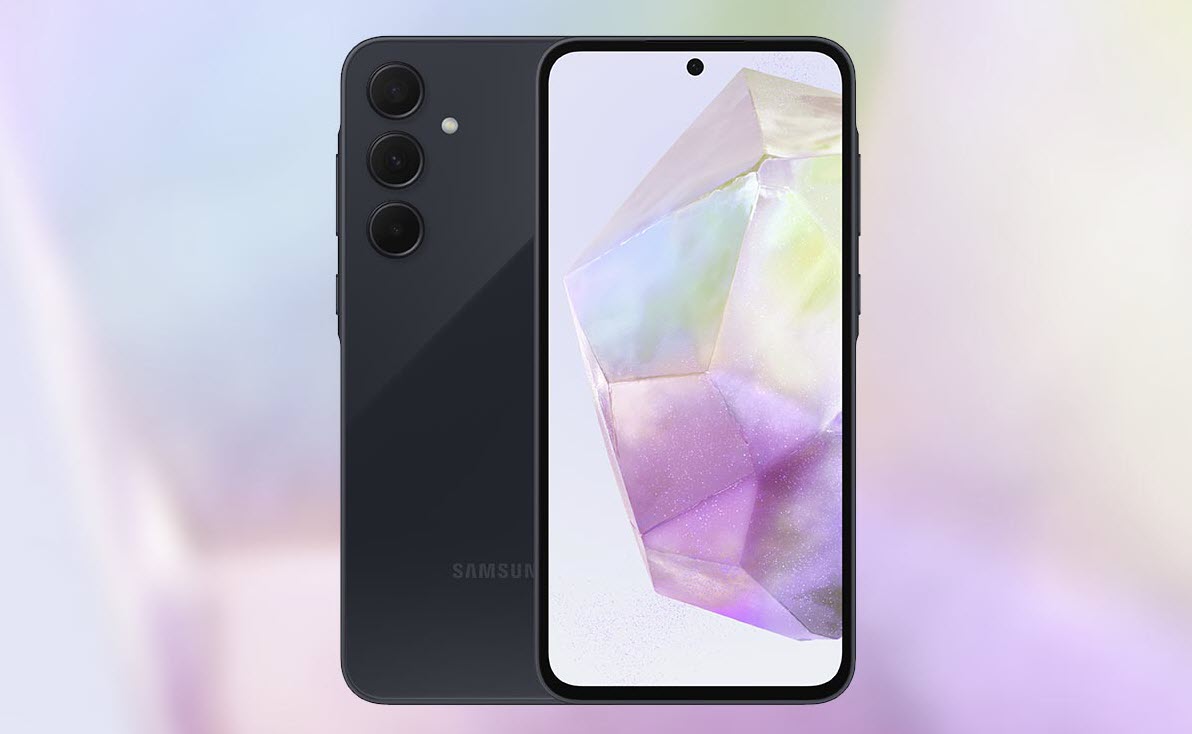
Few mobile phones share as much resemblance as the Samsung Galaxy A55 and Galaxy S23. It’s hard to distinguish them with just a glance, as both feature a triple-sensor floating camera and a display with slim bezels and a punch-hole camera. To tell them apart, attention must be paid to the build and details such as the size and weight of each one, as well as the position of the LED flash, which on the A55 is located diagonally to two of the main cameras, while on the S23 it’s right next to the main sensor.
Next, we have the materials they’re made of. While both have a glass back, the frames of the Samsung Galaxy A55 are made of plastic, whereas those of the S23 are made of aluminum, a more premium and resistant material. Additionally, the Samsung Galaxy S23 is more compact, being smaller, thinner, and narrower than the A55. It’s also much lighter, and that’s because it weighs 45 grams less.
When it comes to the displays, there are more differences between the Samsung Galaxy A55 and S23. Firstly, we can say that the screen of the S23 is better than that of the A55, although it’s also smaller. Its diagonal measures 6.2 inches, while the A55’s is 6.6 inches. Both screens have a refresh rate of 120 Hz, but the Galaxy S23’s is adaptive, being LTPO technology. This allows it to alternate its refresh rate from 1 Hz up to the aforementioned 120 Hz, depending on the current usage and the application or game being run.
The screen technology of the Samsung Galaxy A55 is Super AMOLED, while the S23’s is referred to by Samsung as Dynamic AMOLED 2X. The resolution of both is the same, FullHD+ at 2,340 x 1,080 pixels, as is the touch sampling rate, which is 240 Hz. However, the S23’s screen is much brighter, reaching a maximum brightness of 1,750 nits, whereas the A55’s reaches up to 1,000 nits. Additionally, the glass protecting the screen of the Samsung Galaxy S23 is more advanced and resistant than that of the A55. The S23 comes with Corning Gorilla Glass Victus 2, while the A55 comes with Gorilla Glass Victus+, which is from a previous generation.
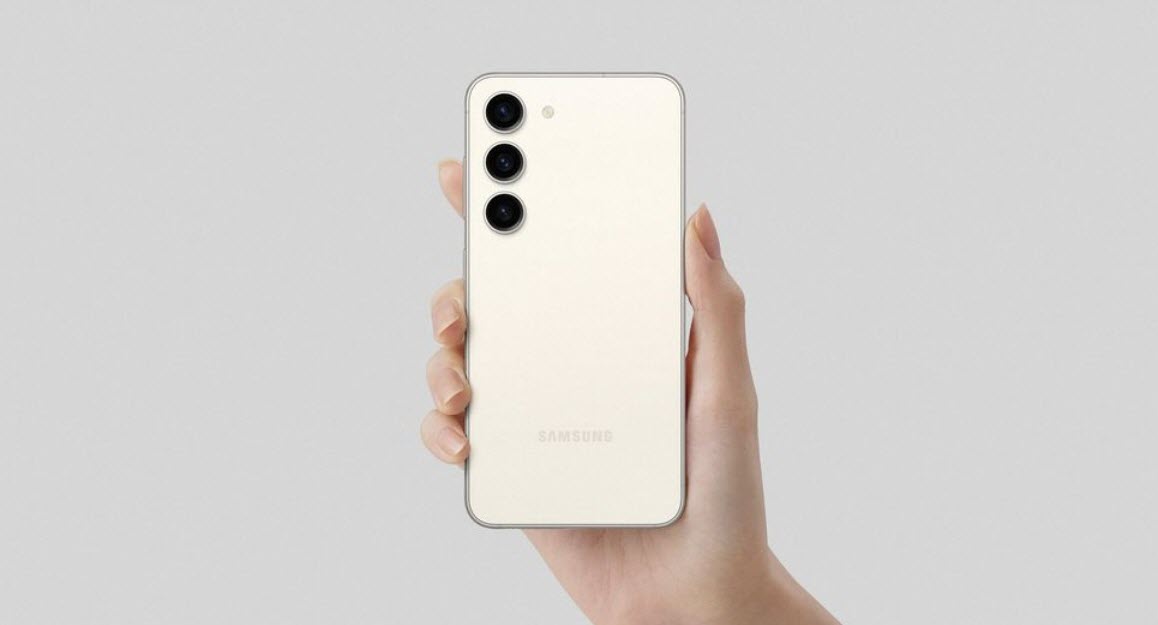
Performance-wise, the Samsung Galaxy S23 takes the lead, being significantly more powerful than the A55, according to AnTuTu benchmarks. The results obtained by the S23 in this benchmark have doubled those of the A55, so there’s little to say about the enormous difference in performance between the two. However, this doesn’t mean that the Samsung Galaxy A55 is slow by any means. Both phones are capable of offering an unmatched user experience. They are both fast and run smoothly on any app and game, no matter how demanding it may be, although the S23 is the king in this regard, without a doubt.
Speaking more in-depth about their processors, the Samsung Galaxy A55 has a fairly new one. This is the Exynos 1480, which debuted alongside this phone and is the successor to the well-known Exynos 1380 of the A54. The node size it boasts is 4 nanometers, so we’re dealing with a fairly energy-efficient chipset. It comes with eight cores that reach a maximum clock frequency of 2.75 GHz.
In the case of the Samsung Galaxy S23, we have the Snapdragon 8 Gen 2, Qualcomm’s most powerful processor for the high-end segment of 2023. This chip also has a 4-nanometer manufacturing process and eight cores, with the difference being that these reach a much higher clock frequency of 3.36 GHz.
The memory options are similar in capacity, but there’s something worth noting. Both phones have 8 GB of RAM and internal storage options of 128 or 256 GB, but the RAM of the Samsung Galaxy A55 is LPDDR4 type, while that of the S23 is LPDDR5. Additionally, the internal memory of the former is UFS 2.2, while that of the latter is UFS 3.1 for the 128 GB version and UFS 4.0 for the 256 GB version. In terms of performance, the RAM and internal memory options of the Galaxy S23 have superior read and write speeds compared to the A55, giving it a performance boost.
Another detail to mention is that only the Samsung Galaxy A55 supports expansion of internal storage via a microSD card. The S23 does away with this feature.
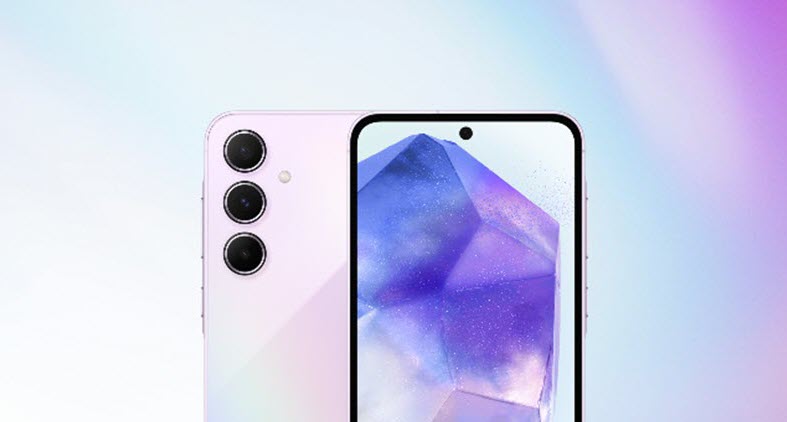
It’s also important to analyze the photographic section in this comparison of the Samsung Galaxy A55 vs S23 to determine which one is better and why, so let’s get into it.
Both the Samsung Galaxy A55 and S23 have a main rear camera of 50 megapixels with an aperture of f/1.8, but the A55 records only in 4K at 30 frames per second, while the S23 records up to 8K, also at 30 frames per second. The quality of photos and videos achieved with the S23 is superior to that of the A55, both during the day and at night. The same goes for the rest of the sensors, which we’ll detail below.
The secondary camera on the Galaxy A55 is a 12-megapixel wide-angle with an aperture of f/2.2. The Galaxy S23, on the other hand, opts for a 10-megapixel telephoto with an f/2.4 focal aperture and 3X optical zoom. The latter also has a wide-angle, also 12 megapixels with an aperture of f/2.2, but in its case, it’s the third and last camera on its back. The A55, instead, uses a 5-megapixel macro with an aperture of f/2.2. The Samsung Galaxy S23 can also take macro photos, but it uses the wide-angle lens for this purpose.
For selfies, the Samsung Galaxy A55 features a 32-megapixel camera with an aperture of f/2.4, and the Galaxy S23 features a 12-megapixel one with an aperture of f/2.2. Despite the difference in resolution, with the A55 offering larger shots, the S23 achieves better results, both in photos and videos. Regarding the latter, both can record in 4K with both, but the fluidity achieved by the A55 is 30 frames per second, and the S23 is 60 frames per second.
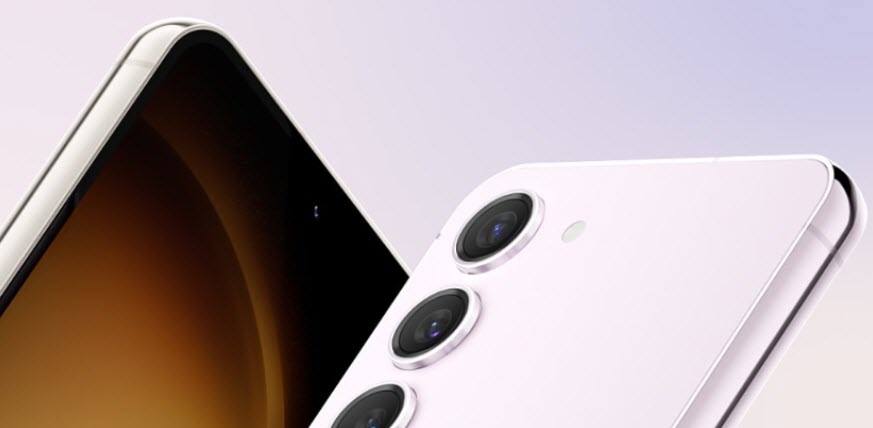
If we take a look at the batteries of both devices, we will find one of the biggest differences between the Samsung Galaxy S23 vs A55. While the S23 has a 3,900 mAh battery, the A55 boasts a much larger 5,000 mAh battery. However, beyond what one might think, the difference in terms of battery life is not very significant. Both phones offer similar battery life, although the A55 performs slightly better in this regard. That being said, both devices support 25W wired fast charging, the typical implementation from Samsung. However, only the Samsung Galaxy S23 supports 10W wireless charging and 4.5W reverse charging, making it superior in this aspect. But one thing both devices lack is a charger in the box; you need to purchase one separately or use one from another phone.
In terms of connectivity, both the Samsung Galaxy A55 and the Galaxy S23 have mostly the same features, except for one area where the latter is superior. We’re referring to the Wi-Fi version; while the A55 has Wi-Fi 6, the S23 comes with the Wi-Fi 6a protocol, which is more advanced. Other than that, both devices support 5G and 4G LTE, Bluetooth 5.3, NFC for contactless payments, GPS with A-GPS, dual SIM support, and USB Type-C input.
Moreover, concerning other features of the Samsung Galaxy A55 and S23, both have facial recognition and an in-screen fingerprint reader, although the A55’s is optical while the S23’s is ultrasonic, a more advanced type that doesn’t require emitting light to function but rather uses sound waves. They also have stereo speakers, but the ones on the Galaxy S23 offer better sound quality as they are tuned by AKG. Additionally, they are both water and dust resistant, but the A55 has an IP67 certification while the S23 has an IP68 rating, making it even more waterproof. Similarly, both are capable of withstanding submersion.
Regarding software, both the Samsung Galaxy A55 and the Galaxy S23 come with Android 14 under One UI 6.1. They also have 4 years of update support. However, since the S23 was released last year with Android 13, it will receive updates up to Android 17. The A55, having launched with Android 14 out of the box, will be updatable to Android 18, an update that will arrive in 2028.
We are about to conclude this comparison between the Samsung Galaxy A55 and Galaxy S23, but not before taking a look at their prices, as here we have another difference to consider.
At the time of writing these lines, the Samsung Galaxy A55 has a starting price of around 480 euros. The S23, on the other hand, can be purchased today for around 560 euros on sites like Amazon Spain. The price difference between one mobile and the other is about 80 euros in favor of the Galaxy A55, being the cheaper of the two, and it will be even greater as the A55 is expected to decrease in price in the coming months.
Now, with this in mind and after having analyzed all the differences between the Samsung Galaxy S23 vs A55, we can say that the winner of this comparison is the Galaxy S23, and very deservedly so. We already explained why…
The Samsung Galaxy S23 is better than the A55 for several reasons. Firstly, it has a more premium design, with aluminum frames, which, in addition to making it more resistant, make it feel more solid in hand. In addition, it is much lighter and more compact. Its screen is also superior in several aspects, despite being smaller. Not only is it much brighter, but it also has an adaptive refresh rate and is protected by a more advanced glass. At the same time, the Samsung Galaxy S23 has a much more powerful processor that makes it ideal for running all kinds of apps and games with maximum possible smoothness. And let’s not talk about the memory options, which are more advanced and have a higher reading and writing speed.
The photographic section of the S23 is also on another level. In addition to capturing photos and videos with higher quality in all kinds of situations, it has a telephoto lens that allows for optical zoom, something that the A55 lacks.
The battery of the S23, despite being smaller, offers similar autonomy to that of the A55. In addition, it has wireless charging and reverse charging, two things that the A55 does not have. The S23 also has a better version of Wi-Fi, as well as a more advanced in-screen fingerprint reader, better stereo speakers, and an IP68 certification.
As points in favor of the Samsung Galaxy A55, it is cheaper, and it will be even cheaper soon when it begins to decrease in price. It also has support for memory expansion via a microSD and will be updateable for one more year to Android 18.